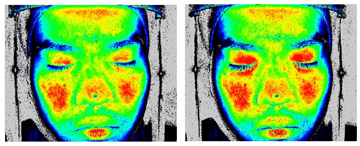Researchers at Tokyo Institute of Technology identify links between the palatability of various tastes and circulation in different parts of the face.
Tastes deemed 'pleasant' increase blood flow in the eyelid according to a recent study by Hideaki Kashima, Yuka Hamada and Naoyuki Hayashi from the Prefectural University of Hiroshima, Kyushu University and Tokyo Institute of Technology. The research identifies links between the subjective perception of palatability with circulatory responses.
The researchers had previously noted changes in the skin blood flow in the eyelid and nose in response to basic sweet, umami (pleasant savoury) and bitter tastes. Now the researchers have extended the study to identify a correlation between changes in circulation in specific parts of the face and the subjective palatability of different complex tastes such as the sweet and sour taste of orange juice.
They studied the responses of 15 test subjects to the taste of sweet chilli sauce, orange juice, bitter tea, coffee and soup, and a water control. All samples were tasted by pipette at the same lukewarm temperature, 40.3 ± 0.2 °C. A conductance index was calculated from the measured skin blood flow as a ratio of the mean arterial pressure.
Chilli was found to increase blood flow in all measured areas irrespective of the palatability rating given by the subjects. However, as the researchers point out, when changes induced by chilli sauce were excluded there was a significant correlation between the palatability ratings the test subjects gave and the conductance index values in their eyelids.
"These results suggest that the facial circulatory response reflects the degree of palatability of a foodstuff," conclude the researchers. Since smell also contributes to the palatability of food, it will be interesting to study further the study to consider the influence of different smells on skin blood flow.
Methods
Circulation measurements
The researchers collected skin blood flow data from the test subjects' forehead, eyelid, nose and cheek using laser speckle flowgraphy. The data was recorded 5 s before stimulation and 20s after stimulation. In addition the skin blood flow in the right index finger was measured by laser Doppler flowmetry.
The researchers also continuously monitored the heart rate and mean arterial pressure using an automatic sphygmomanometer applied to the subject's left middle finger.
Subjective test subjective scoring
The test subjects retained the taste sample fluids in their mouths for 30s before swallowing and then rinsed their mouths with pure water at 40 °C until the taste had gone. They rated the tastes on six eleven-point visual analog scales, one for palatability and one for the intensity with respect to each of the five tastes sweet, sour, salty, bitter and spicy. The ratings scaled from +5 (the most pleasant) through 0 (no change) to -5 (the most unpleasant).
Results and suggestions
CI in the eyelid increased significantly in response to chilli sauce, orange juice and soup, while CIs in the forehead, nose and cheek decreased in response to bitter tea.
There was a significant correlation between the palatability scores and CI values in the eyelid when changes induced by chilli sauce were excluded. These results suggest that the facial circulatory response reflects the degree of palatability of a foodstuff.
The conductance index in the nose was not found to be related to palatability scores, however bitter tea caused vasoconstriction in the nose. Similar vasoconstriction in the nose has been observed in response to the discomfort of electrical stimulation of a finger or teeth. Temperature decreases have also been noted around the noses of rhesus monkeys in response to negative emotions, and are likely the cause of the observed vasoconstriction in the nose in response to bitter tea. The researchers explain the mechanism in terms of the nose's high quantities of arteriovenous anastomoses controlled by adrenergic vasoconstrictor nerves. While the vasoconstriction is strongest in the nose, previous studies have noted sympathetic vasoconstrictor activity in the forehead and cheek, as noted by the researchers in the current study.
In the current study orange juice was found to significantly increase skin blood flow in the cheek but did not alter the conductance index as the mean arterial pressure also increased possibly via sympathetic activation. In contrast skin blood flow in the forehead was not found to increase at the taste of orange juice although it had been noted in response to cold pressor tests.
Reference
Hideaki Kashima, Yuka Hamada, Naoyuki Hayashi, "Palatability of tastes is associated with facial circulatory responses" Chemical Senses, 2014 (Article first published online: 5 Jan 2014).

Figure Change in facial blood flow before (left panel) and during eating consommé soup. This subject felt tasty to consommé soup. Red shows greater blood flow and blue shows lower blood flow. Note that blood flow in eyelid increased with eating tasty soup.
. Any information published on this site will be valid in relation to Science Tokyo.



